|

|
|
|
Where2watch
birds in Asia |
Stijn De Win
Philippines
birding info

We love the Philippines!
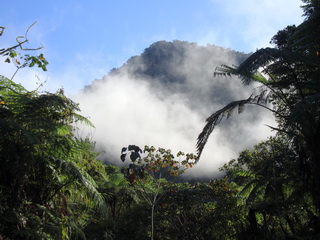
View from the last farm clearing.
More info, less2read
Preliminary bird list for
Mt. Dulang-dulang
Oriental Honey-buzzard
Barred Honey-buzzard
Black-shouldered Kite
Brahminy Kite
Besra
Chinese Goshawk
Crested Goshawk
Grey-faced Buzzard
Philippine Serpent Eagle
Philippine Eagle
Rufous-bellied Eagle
Pinsker’s Hawk Eagle
Peregrine Falcon
Buikidnon Woodcock
White-eared Dove
Amethyst Dove
Yellow-breasted Fruit-Dove
Philippine Cuckoo-Dove
Spotted Dove
Zebra Dove
Emerald Dove
Mindanao Lorikeet?
Mindanao Racquet-tail
Colasisi

Philippine Hawk-Cuckoo
Oriental Cuckoo
Rusty-breasted Cuckoo
Philippine Coucal
Mindanao Scops-Owl
Giant Scops-Owl
Philippine Frogmouth
Great-eared Nightjar
Philippine Nightjar
Philippine Swiftlet
Glossy Swiftlet
Purple Needletail
Whiskered Treeswift
Philippine Trogon
White-throated Kingfisher
Collared Kingfisher
Blue-capped Kingfisher
Mindanao Hornbill
Coppersmith Barbet
Philippine Woodpecker
White-bellied Woodpecker
Buff-spotted Woodpecker
Barn Swallow
McGregor’s Cuckoo-shrike
Pied Triller
Yellow-vented Bulbul
Philippine Bulbul
Spangled Drongo
Black-naped Oriole
Elegant Tit
Sulphur-billed Nuthatch
Stripe-breasted Rhabdornis
Bagobo Babbler
Brown Tit-Babbler
White-browed Shortwing
Pied Bushchat
Sunda Thrush
Island Thrush
Eye-browed Thrush
Mountain Leaf-Warbler
Tawny Grassbird
Striated Grassbird
Rufous-headed Tailorbird
Long-tailed Ground-Warbler
Goodfellow’s Jungle-Flycatcher
Grey-streaked Flycatcher
Mountain Verditer Flycatcher
Mugimaki Flycatcher
Snowy-browed Flycatcher
Little Pied Flycatcher
Black-and-cinnamon Fantail
Black-naped Monarch
Yellow-bellied Whistler
Grey Wagtail
Eastern Yellow Wagtail
Paddyfield Pipit
Olive-backed Pipit
White-breasted Woodswallow
Long-tailed Shrike
Mountain Shrike
Brown Shrike
Short-tailed Starling
Coleto
Apo Myna
Olive-backed Sunbird
Grey-hooded Sunbird
Apo Sunbird
Olive-capped Flowerpecker
Red-striped Flowerpecker
Buzzing Flowerpecker
Fire-breasted Flowerpecker
Mountain White-eye
Black-masked White-eye
Cinnamon Ibon
Eurasian Tree Sparrow
White-bellied Munia
Chestnut Munia
Mountain Serin
White-cheeked Bullfinch
---------------
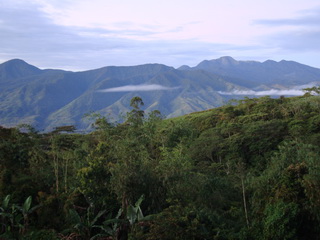
As seen from the track up to
Mt. Dulang-dulang a view on
Mt. Kalatungan Range Natural Park
-Lots of forest up there!!!-
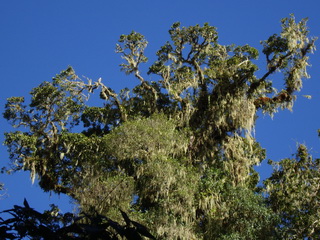
A mossy one
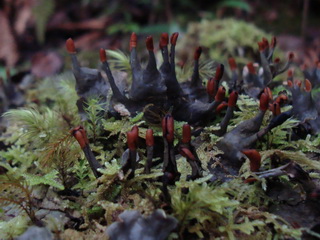
Plenty epiphytes as well
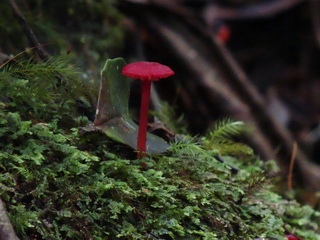
Very red and very small
but more than enough
to feed the dragon...
All photographs taken on
Mt. Dulang-dulang
by Stijn De Win
------------
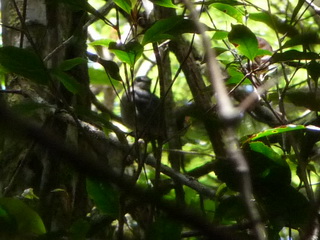
Goodfellow's Jungle-Flycatcher
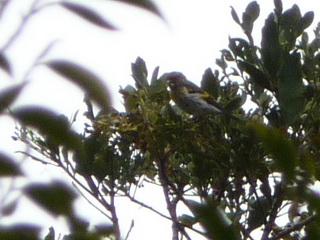
Mountain Serin
A couple record shots taken
on Mt. Dulang-dulang
by Andy Goodwin
in March 2012 |
|
Mount Dulang-dulang, Mindanao, Philippines.
Kitanglad, the other side. |
|
The Kitanglad mountain range features relatively easy access to some of the best birding in the Philippines. This is where most birders connect with ‘the Eagle’. Kitanglad perhaps is the best place to go if you wish to see Mindanao’s montane specialities and endemic birds. For many it may simply be the only option I believe. To visit Kitanglad has always been equated with a stay at the basic Del Monte lodge… Euh, don’t you possibly need an alternative??? Yes, probably you might well do need one!!! I mean, you are an independent birder, travel on your own or just a couple of you. Additionally you are reasonably fit and able to do some good uphill walking. You’re a keen birder and able to find birds on your own… So, you may have found logistics for going Del Monte a nightmare and I assume you may come second as for your choice of dates of travel during the busy spring season. It is true, during February and March the lodge gets very busy and booked out with organized birding tours. I’m not even completely sure they would like to cater for just a single birder or a couple wanting to stay. In the end it’s a whole family up there running the lodge just for birders alone. They need to be paid and costs may rise.
Alternative did you say? I mean, not just an alternative. At the back side of Mount Kitanglad lies a prime birdwatching site. Call it Binahon (Henry’s farm) or simply the trail up Mt. Dulang-dulang. This is part of the Kitanglad mountain range and very close to Del Monte as the crow, I mean Eagle, flies. It’s just the other side. Only a handful of birders have visited so far. Under watched and underrated. It must be a coincidence that two other parties besides Bob and myself visited this Feb. – March 2012. We were surprised to find Mountain Serin (twice in a day) only to get this confirmed by sightings of Andy, and I heard also Marc and Pete saw the Serins up there. Looks like a regular resident bird. These may well be the first sightings in the Kitanglad range made by birders. Check the Kennedy field guide (‘only known from specimens’) and someone claimed to me a biodiversity team on Kitanglad in 1996 may have found them as well… Ah well, time to send some birdwatchers up there I guess. I mean, my friend Andy Goodwin (from the first Blackbird for the Philippines; story 1) on his first Mindanao visit, was booked for Del Monte but did cancel his visit. No wonder, the only potential new bird for Andy would have been Red-eared Parrotfinch after having birded Mt. Dulang-dulang for 5 days. That does include 2 Philippine Eagle sightings. That does include Goodfellow’s Jungle Flycatcher and Bagobo Babbler, both of which you may have very little chance on finding at Del Monte!!! All right I have got you interested. That’s all we need.
|
| Key species and expectations |
|
As for key species, I would say they include just about anything a visit to Del Monte lodge on Kitanglad could produce, except perhaps Red-eared Parrotfinch and also Philippine Eagle sightings are by no means guaranteed, I mean less regular than at Del Monte to say the least. On the other hand this is ‘the’ place to connect with Goodfellow’s Jungle Flycatcher and Bagobo Babbler. Mountain Serin has never been seen at the Del Monte side of Kitanglad. We have proved it a regular bird up Mt. Dulang-dulang this spring I reckon. This endemic race mindanensis is well worth seeing with its heavy blunt bill and a lack of white around the eye. Additionally, at Del Monte one can only go as high as about 1900 meter above see level (trail horribly overgrown further up) which is too low for Mindanao Lorikeet. Both Andy and myself did hear unfamiliar soft Parakeet-like sounds thought to be this species. Mist and canopy cover respectively prevented a sighting but things look good, to be confirmed soon! A sound recording could help but doesn’t seem to be available yet.
Anyway, with few birders having so far visited and only a daytrip by Bob and I, it is hard to figure out the right expectations for a visit. Our day list as of 27 Feb. 2012 may give an insight on what is possible in a day.
Oriental Honey Buzzard, Philippine Serpent Eagle, Peregrine, Bukidnon Woodcock, Philippine Cuckoo Dove, Yellow-breasted Fruit Dove, Rusty-breasted Cuckoo, Philippine Coucal, Great-eared Nightjar, Glossy Swiftlet, Philippine Swiftlet, Blue-capped Kingfisher (H), Philippine Woodpecker, White-throated Kingfisher, Buff-spotted Flameback, Barn Swallow, Grey Wagtail, McGregor’s Cuckoo-shrike, Pied Triller, Yellow-vented Bulbul, Philippine Bulbul, White-browed Shortwing, Long-tailed Bush-Warbler, Rufous-headed Tailorbird, Mountain Warbler, Tawny Grassbird, Mugimaki Flycatcher, Little Pied Flycatcher, Mountain Verditer Flycatcher, Black-and Cinnamon Fantail, Yellow-bellied Whistler, Brown Tit-Babbler, Elegant Tit, Sulphur-billed Nuthatch, Grey-hooded Sunbird, Mount Apo Sunbird (common), Olive-capped Flowerpecker, Fire-breasted Flowerpecker, Mountain White-eye, Black-masked White-eye, Cinnamon Ibon, Long-tailed Shrike, White-cheeked Bulfinch 2 birds, Mountain Serin 2x.
|
| Birding |
|
Binahon Agroforestry Farm where you can either stay or base yourself for camping higher up the mountain lies at about 1300 meter altitude. (Same elevation as Del Monte lodge.) The summit of Mt. Dulang-dulang is 2938 meter above sea level which makes it the second highest mountain of the Philippines. Birding business goes in between these points. From Binahon Farm a track goes up to about 1800 masl, from there a very good trail leads all the way to the summit.
-Option 1; stay in a room at Binahon farm;
Technically, it would be possible to walk up and down to the summit from Binahon Farm in a single day. You would need to be seriously fit though and it won’t leave much time for birding on the way although if you’re keen on not doing any camping, one good approach would be to bird the lower sections on previous days and just go for birding the summit area only on the big day. Still it wouldn’t get you up to the summit early in the day which seems important as clear skies usually only lasts to about mid-morning. Mist may come in very quick and would seriously reduce visibility.
Another good tactic to avoid camping would be to limit your birding to about 2100 meter above sea level. This is what we did on our day trip. Walked up slowly in about 6,5 hours birding on the way and had lunch by a stream crossing. Back down in about 4 hours. Everything can be seen on this stretch I believe. Only a real chance on the Mindanao Lorikeet would wait for you higher up that’s for sure.
-Option 2; camping;
To camp up would, most importantly, cut out the only one “catch” to this birding site. That is the uphill walk each morning from Binahon Farm. I mean, although some birds can be seen lower down in little woodlots, it took us an hour and 45 minutes to reach the forest proper. It is best to do this daily uphill walk before dawn when it is cool still.
On the other hand, -I’m not sure still what is best-, to camp up would require organizing porters, food, water, someone to stay with the tents etc. Henry can help. Remind that a (warm) sleeping bag is required. It’s cold up there at night. And the weather can turn violent higher up…
See for possible camping spots next paragraph; |
|
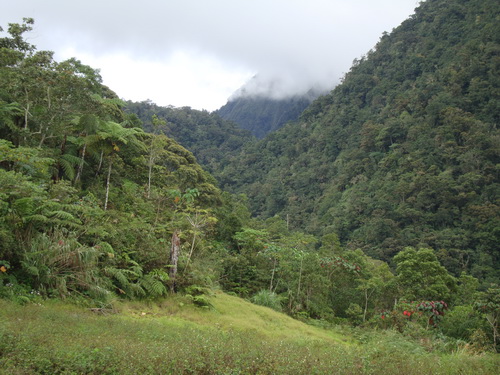
|
|
The rough overgrown field mentioned, with the 'Eagle' view up the valley. |
|
Birding your way up;
-Please note this is only a ‘sketch’ description for birding Mt. Dulang-dulang trail. I’d love to visit again ‘with’ bringing my GPS. Anyway, please note you should only go up there with Henry or another trail guide arranged through Henry. Permit is required as well.
-From the accommodation at Binahon Agroforestry Farm (Giant scops Owl calls at night sometimes) the main track climbs up through fields and eucalyptus woods (Bukidnon Woodcock pre-dawn) and after 1h45 min. passes a rough overgrown field on the right with fine views up the forested valley. (Pinsker’s Hawk Eagle and 1 sighting of Philippine Eagle by Andy in March 2012, and we heard Blue-capped Kingfisher calling from this field by the forest edge.) Description of the location of this field may appear brief but once there you will know as this is the last open area. Immediately after the field the track enters good secondary forest. Stuff seen even before this point in little woodlots and edge includes Long-tailed Ground Warbler (common), Cinnamon Ibon, Sulphur-billed Nuthatch, Philippine Coucal, Grey-hooded Sunbird, Black-masked White-eye, Philippine Swiftlet, Eye-browed Thrush… The tall secondary forest mentioned is real good and productive. Once entered you may expect some goodies and mixed flocks that move through. Sulphur-billed Nuthatch, Black-and-cinnamon Fantail, Black-masked White-eye, Olive-capped Flowerpecker, Mountain Leaf Warbler, Little Pied Flycatcher, Mindanao Hornbill, Stripe-breasted Rhabdornis, Rufous-headed Tailorbird, Yellow-bellied Whistler, Elegant Tit…
After about half an hour at birding pace you may reach the end of the track and the last small farm clearing in the forest. This clearing can be very good birding too. (Apo Myna) It’s your last chance on raptors before moving up in closed canopy. This includes Philippine Eagle (Another sighting here of 1 crossing the valley by the far end of the clearing by Andy in March 2012), Oriental Honey Buzzard and Philippine Serpent Eagle. The clearing is a good spot to hang around for a while and that’s not just for waiting for the Eagle. Lots of birds move through incl. flocks. You may want to have breakfast here or take a snack. It would serve as a good camping spot as well. Chilly but not very cold yet being at 1800 meter altitude. It would cut out this uphill ‘push’ every morning but remember you’re still a long way below the summit.
-Take the trail from the left hand side of this last clearing to enter primary forest. The first 100 meter is very steep (we had 2 males Apo Sunbird at eye-level and just 3 meters away) but after that a gentle steady climb. The trail is good and the beautiful mossy forest of superb quality although bird density might appear low. We went birding slowly up for several hours to a stream crossing over a crest at about 2100 meter and had lunch by the stream. This could serve as another camping spot. Marc and Pete heard Mindanao Scops Owl here. I believe the stream can be reached from Binahon farm in about 4 – 5 hours at a reasonable walking pace. We did it in 6,5 hours birding our way up.
There’s real good birds up here on this stretch of the trail; both Goodfellow’s Jungle Flycatcher and Bagobo Babbler seen by Andy, Mountain Serin, White-cheeked Bullfinch, Island Thrush, Apo Sunbird is common although mostly heard, Yellow-breasted Fruit-Dove, McGregors Cuckooshrike, Buff-spotted Flameback, White-browed Shortwing…
-The trail actually forks by the crest mentioned earlier. The right hand fork leads to the stream and our lunch spot from where it continues up to the summit of Dulang-dulang which is another 900 alti-meters higher up (at least 3 hours walk I guess). About 20 minutes before the summit you’ll find yourself at a place called Manny’s Garden campsite. (very cold overnight) Bukidnon Woodcock breeds here. Above Manny’s Garden is a low alpine heatland called Manny’s Garden where you may find Apo Sunbirds feeding on shrubbery with tubular flowers. Andy saw big flocks of Mindanao Racquet-tails and heard possible Mindanao Lorikeet calls. There’s a shrine up there and another 10 min. steep climb brings you to the summit.
-We had Mountain Serin and White-cheeked Bullfinch on the main trail shortly before the crest in the path mentioned earlier. From this crest, if you take the obscure trail to the left is where Andy had his Mountain Serins shortly after, with White-cheeked Bullfinches. This trail climbs for several hours to the summit along a ridge. From the summit you can descend back down to Manny’s Garden.
|
| Getting there |
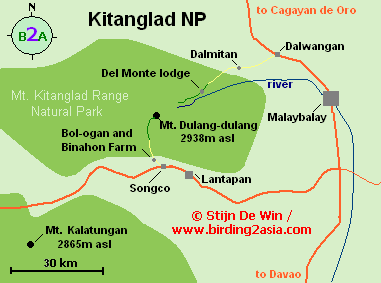 |
We did visit as a little extension after our
Feb. 2012 Philippines tour
which ended at Del Monte – Kitanglad.
-Otherwise simple; Fly to Cagayan de Oro which has numerous daily flights from Manila and Cebu and a few from Davao + some other domestic routes. When you exit the airport you can be sure drivers will approach you. Get a ride to Malaybalay city. (2,5 hours) It is possible to reach here on public transport as well. (check your travel guidebook) Arrange pick-up with Henry Binahon from there. Alternatively you could continue with your hired car up to Lantapan or all the way to the village of Bol-ogan but it would be more complicated to connect and meet with Henry. Anyway, ask him. From Malaybalay to Binahon Farm is about 2 hours. | |
| Logistics and monsters... |
|
Henry Binahon is a nice guy and runs Binahon Agro Forestry Farm. He welcomes birders, trekkers, eco-tourism… Henry can do all arrangements for you. This includes pick-up from Malaybalay city, get your permit from the DENR for Kitanglad range National Park, camping, porters, etc. Henry can guide you up the mountain (very limited knowledge about birds though) or arrange another trail guide if he’s busy. Just as for a visit to Del Monte, also on this side of the mountain they have this compulsory cleaning ritual incl. offering of a chicken etc. The old days are over though and you may but do not need to attend any more. Just pay the fee of 2000 Pesos. Anyway, it didn’t help us as we still managed to meet a monstrous beast in the dark forest interior. There’s only 1 living up there and it’s called the dragon of Dulang-dulang. It thrives in the fabulous environment of moss-clad ancient oaks, ferns, epiphytes and crimson-red mushrooms… Of course you do not believe me ha! Anyway, I managed a photo so you may know what I mean; |
|
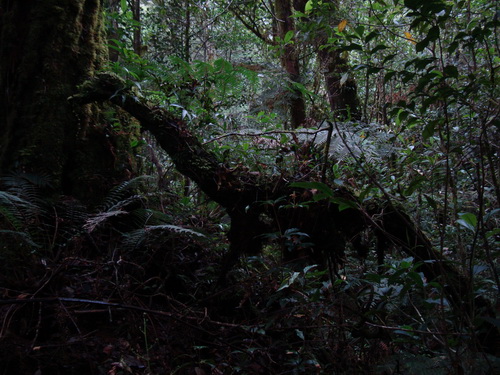
|
|
Henry has a website and can easily be contacted via email or phone.
http://binahonagroforestryfarm.blogspot.com
Binahon Agroforestry Farm (BAFF) is located in sitio Bol-ogan, at barangay Songco, in the municipality Lantapan, in Bukidnon province, The Philippines.
Mobile phone numbers:
+63 (0)9059071771 or
+63 (0)9106143237
Email: binahonagroforestryfarm@gmail.com
|
| Accommodation at Binahon Farm |
|
Besides a dormitory, there’re 3 fairly basic double rooms at the farm. I should mention one of those rooms, located up a rather difficult wooden stairway is quite nice and cosy with a good sitting area/balcony in front. Facilities are outside. Sit-down toilet/scoop flush and a big bowl of hot water you may ask for the shower.
|
| Food |
|
Very good with lots of fresh vegetables from the farm. Includes stuff like broccoli which is very rare in supermarkets in Philippines. In those places you can get them (Robinson’s), expect prices 3 times as much as in western Europe…
On the other hand, as for Binahon, actually the whole village or even mountain, what can I say;
“I shall return”, like MacArthur ha. (click link to Google) For birding perhaps but most importantly to learn the poor up there make the real Belgian fried potatoes. I'm a man on a mission. The world will become a better place…
-So we went for a walk with Henry who told us;
5am breakfast; We eat a lot of rice. We will have rice.
6am walk; Rice is our staple food.
7am walk; We love rice.
8am walk; Rice is delicious, we need lots of it.
9am snack; We have rice 5 times a day.
10am walk; Rice is important, it is our staple food.
11am walk; Rice is our food!
At noon; We brought lots of rice 2000m up the mountain. Let’s eat lunch now.
Euh, Henry, sorry but may I ask why don’t you do potatoes? I mean, you have the perfect climate up here, a good soil if you fertilize etc. And lots and lots of space to grow potatoes. I see all those fields that aren’t worked. Imported rice from the lowlands has to come in from far and must be expensive? The people up here seem to be poor. Why not grow some potatoes in the backyard? Ha, dear Stijn, potatoes gives us stomach-ace. Rice is our food. Ah, ok Henry, I understand. Sorry for asking.
7pm dinner; On this special occasion, I suspect because of our conversation at noon, we do get some unfamiliar vegetable look-alikes, sliced like fries and mixed with the lightly stir-fried vegetables. Euh Bob, these crispy raw ones, aren’t they potatoes? Euh yes Stijn, they are… Euh, my mother told me at young age potatoes need to be cooked… nightshades you know…glycoalkaloid poison…stomach upsets…
http://listverse.com/2009/01/06/top-10-poisonous-foods-we-love-to-eat/
|
| Costs |
|
Very reasonable with accommodation and food cheap. Permit and add-ons cost a little especially if on a short stay. As of February 2012;
-NP permit 750 Pesos pp
-Accommodation and food full day 800 Pesos pp
-Ritual 2000 Pesos (paid once and per group for the whole stay)
-Porter for full day up the mountain 300 Pesos
-Guide and facilitation fee 1500 Pesos per day total for the group. Note this was charged 3 days to us even though we only arrived in the afternoon (did nothing but rest) and after a full day left in the morning after a lie in.
-4WD transport to nearby town 10 km away to connect with our van back to Cagayan 500 Pesos.
-The money we spent best though was 90 Pesos on 1 liter “Red Horse”. Stunner!
|
| Notes and additional info |
|
-The best season to visit is probably February through to at least late May. Allow as much time as you can for any visit as at Katinglad you may be affected by bad weather at any time of the year.
-Binahon Farm and Mt. Dulang-dulang are safe places to visit. I have checked this personally with the superintendent of the Kitanglad range National Park. I’ve been told that while there have been some safety issues at the Del Monte side of the mountain in the past, this has never been the case for Mt. Dulang-dulang.
-Here’s a page on the Kitanglad range National Park by the Department of Environment and Natural Resources of the Philippines;
http://www.denr.gov.ph/index.php/component/content/article/364.html
|
|
Top / home / locations / visit Kitanglad –Del Monte
| |
|
This information page published on 26 April 2012 by Stijn De Win. Copyright © Birding2asia.com  All rights reserved. All rights reserved. | |